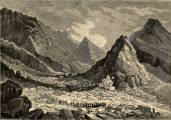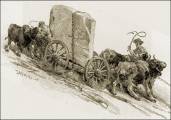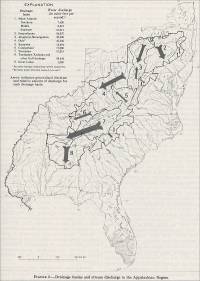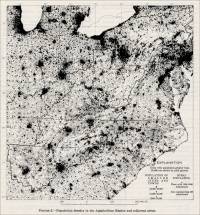


Geography
By R. A. Weeks, R. D. Zahnizer, and
G. L. Chute, U.S. Geological Survey
Appalachia, as defined legislatively, is an irregular shaped area of 185,000 square miles, extending from New York to Alabama. It is about 950 miles long from northeast to southwest and averages 250 miles in width, as shown in plate 1. It includes West Virginia, most of Pennsylvania, and parts of 10 other States. Most of the area is mountainous or hilly, and the major uplands of the eastern United States, collectively known as the Appalachian Highlands, are included within Appalachia. This area differs substantially from the surrounding region in geography and economic development.
The rough terrain limits the amount of arable land and provides barriers to access and through transportation routes; historically the area was bypassed during the settlement of the interior of the continent. Industrialization focused interest on the mineral and fuels resources of the Appalachian Highlands only after the rich farmlands of the Mississippi Valley had been settled. Settlement and development in earlier years followed the streams and valleys, then branched out to tape coal, oil, and a variety of mineral rock products. Agrarian development has been limited to small tracts that vary substantially in fertility, and greatest emphasis has been on livestock, dairy products, and cash crops. Forests are extensive, and important wood-products industries have developed. Most towns are small, because of the limited population in their market areas.
The Appalachian Highlands are dissected by streams and rivers, most of which flow either into the Atlantic or into tributaries of the Mississippi River. A few streams flow to the Great Lakes, and some flow directly to the Gulf of Mexico. Summits along the drainage divide include the highest elevations in the eastern half of the United States. Many summits approach or exceed 6,000 feet, and Mount Mitchell, in North Carolina, is 6,684 feet high.
The pattern of hills, ridges, and mountains, together with their stream systems, depends on the nature of underlying rocks. Four distinctive patterns occur in the Appalachian Highlands, each designated as a physiographic province. The easternmost is the Blue Ridge, in part linear and elsewhere massive. The Valley and Ridge province to the west is characterized by long ridges separated by deep valleys; stream systems tend to be angular and of the type known as trellis pattern. Next westward is the Appalachian Plateaus province, underlain by relatively flat-lying strata; stream patterns are dendritic. A small part of western Appalachia is in the Interior Low Plateaus province, where drainage is dendritic and in some areas is subterranean where it traverses limestone.
Surrounding these uplands are the Piedmont province on the southeast, the Coastal Plain provide on the southwest, and the Central Lowland province on the northwest. The specific physiographic features characteristic of each province are described by Davies in the following section on "Physiography."
As an interior upland mass, Appalachia has a climate distinct from that of surrounding areas. It is characterized by cooler temperatures and greater rainfall. Summer temperatures reach the mid-90's in the higher parts of the area and range as high as 109° F elsewhere. Winter minimum temperatures of record range from about -20° F in the north to a few degrees above zero in the south. Statistical averages conceal the extremes; average annual temperatures are about 50° F in the north and above 60° F in the south.
Precipitation averages about 47 inches annually, much above the national average for regions of comparative size. Most is derived from eastward-moving masses of air that lose their moisture as they are forced upward over the mountainous area. High precipitation thus tends to occur along the western sides of mountain ranges, and distinct rain shadows are found east of them. The highest average annual rainfall, which occurs long the western side of the Blue Ridge in North Carolina and Georgia, is about 80 inches. Rainfall also increases from north to south, from an annual average of about 35 inches a year in New York and northern Pennsylvania to more than 55 inches in Alabama.
Precipitation is the source of an adequate supply of water reasonably well distributed between the growing and nongrowing seasons. Most summer rain falls during thunderstorms, which occur 30-35 days per year in the northern part of the region and as many as 60 days per year in Alabama. Thunderstorms may produce intense rainfall and cause crop damage and severe local flooding. Snowfall ranges from more than 100 inches in the higher elevations in the north, where individual storms may drop more than 20 inches of snow, to less than 3 inches in Alabama.
The large amount of surface water produced by precipitation moves seaward along well-developed stream systems toward the Atlantic and the Gulf of Mexico. In the highlands, streams are fast and narrow and move large amounts of water.
Stream systems flowing into the Atlantic originate in the Appalachian Plateaus in the north and in the Blue Ridge in the south. Their patterns and valley shapes reflect structure and relative resistance of underlying rocks. In headwaters, valleys are narrow and steep sided, broadening and flattening downstream, except where cutting through hard rock ridges. Stream patterns are dendritic in the plateaus and trellised in the Valley and Ridge province and in the Blue Ridge. After emerging from the uplands, streams flow in open valleys southeastward across the Piedmont and the Coastal Plain. Some streams descend as much as 2,000 feet in 3 miles as they emerge from the Blue Ridge. As they coalesce downstream, they develop into broad rivers with slower flow but greater total discharge. Discharges of major basins differ, as shown in figure 2.
Figure 2. Drainage basins and stream discharge in the Appalachian Region.
Stream systems draining into the Gulf of Mexico via tributaries of the Mississippi River originate in the western part of the Appalachian Plateaus in the north and in the Valley and Ridge province in the south. Stream patterns and valley shapes reflect comparable control of underlying rocks. Most northern streams exhibit dendritic patterns and are deeply incised; in many places they flow more than 1,000 feet below the nearly flat but discontinuous plateau surface. Relief tends to be subdued in the northernmost part of Appalachia where glaciation modified the topography. Toward the south, streams may head in the Blue Ridge where drainage is dendritic or in the Great Valley on the east side of the Valley and Ridge province, where relief is low. The streams traverse north east-trending hard-rock ridges through spectacular steep-sided water gaps and are fed by tributary streams that follow the interridge valleys. Beyond this area of trellised drainage, master streams out through the plateaus where tributaries again resume dendritic patterns.
Rainfall in Appalachia averages 47 inches per year. Twenty to thirty inches is surface runoff (Schneider and others, 1965); the balance seeps underground or is lost through evaporation and transpiration by plants. Runoff closely follows the pattern of precipitation. To cite an extreme case, the Blue Ridge of North Carolina shows a pronounced rain shadow; rainfall on its west flank averages nearly 80 inches per year, more than 25 inches greater than that on its east flank. Average runoff on the west flank is 40 inches per year and on the east flank it is less than 15 inches per year. Seasonal runoff is highest in the spring, when melt water from snow and rain combine, and is lowest in the fall.
The quality of water in streams varies with the amount of runoff as well as with stream environment and land- and water-use patterns. In about 90 percent of Appalachia, dissolved solids in stream waters are less than 300 ppm (parts per million), and most Appalachian streams have soft or only moderately hard water. Hard water is apt to be found in a few streams during periods of low flow and in parts of the region where the streams have been contaminated, either by men's activities or by natural infiltration of saline waters (Schneider and others, 1965). Water pollution may present problems in some parts of Appalachia, but the overall supply of usable water can be maintained by good management. Perhaps the major pollution of water exists in the coal-mining regions of northern Appalachia, where mine waste and the flow of ground water through active and abandoned mines adds a variety of solid and chemical contaminants to surface water.
In summary, a large amount of water of good quality is a major resource of Appalachia. This resource can be applied to development of new industry and also to generation of hydroelectric power, as described by Arthur Johnson in the section on "Waterpower Resources." Thermoelectric plants using large amounts of water are being built in great numbers and this trend should continue. Many potential industrial and power sites exist along Appalachia's extensive stream and river systems.
Small to moderate quantities of ground water are available throughout most of the region (Schneider and others, 1965) and are abundant locally. Aquifers are the source of the water for many springs and seeps that maintain the base flow of many streams. In areas underlain by limestone, a good part of the drainage follows subterranean routes at various depths through channels dissolved out of the rock. Ground water is largely undeveloped throughout much of the sparsely populated parts of the region, but has been extensively developed in and near some cities. Where available it is a vital resource for industries that require water of uniform temperature, uniform chemical composition, and low content of suspended solids. The availability of ground water in various parts of Appalachia should attract new industries, particularly those that are meeting local shortages of ground water in areas peripheral to Appalachia.
From the earliest days of national development, major transportation routes were designed to traverse Appalachia and to link the Mississippi Valley to the eastern seaboard. Trails and roads, canals, and subsequently railroads, all followed waterways, crossing ridges at water gaps and wind gaps. Of the natural features encountered, the Allegheny Front of the northern Appalachians was the most formidable barrier and required the maximum engineering ingenuity to surmount its grade. Spur roads and railroads connected outlying settlements with the through-going routes as the country filled up. It was only the advent of automotive vehicles that transportation routes could be built without regard to water-level grades.
Appalachia is not entirely hilly. Uplands such as the Appalachian Plateaus are relatively accessible by automotive vehicles, and the Great Valley on the east side of the Valley and Ridge province always has provided access along the length of the region. The Interior Low Plateaus to the west and the intervening basins and the areas bordering the Great Lakes on the north are fairly easy terrain for constructing transportation routes. The Ohio Valley below Pittsburgh always has been a natural corridor to the Mississippi Valley; more recently the Tennessee Valley has been developed by means of dams and locks to provide a southern waterway into the region. Even within the rougher areas, modern earth-moving equipment is being used to construct direct new routes and to straighten older sinuous roads and railroads.
Modern engineering also has made it possible to construct fuel pipelines and electrical powerlines across the roughest terrain of Appalachia. Pipelines supply many sections with petroleum products and natural gas, and transport oil and gas from the many producing fields of the region to refineries.
Population, Industry and Agriculture
The rugged terrain throughout much of Appalachia made the region generally more difficult to develop than the surrounding land of more subdued topography. Earliest settlements grew up and around military and trading posts. The settlements at intersections of major transportation routes were on sites that naturally favored growth, especially where local sources of raw materials were at hand.
After nearly two centuries of national development, most of the region still is sparsely populated. According to the national census, the total population was 17,261,445 in 1960 (table 17). Figure 3 shows the distribution of population. Only 19 cities have populations greater than 50,000; only 7 of these have more than 100,000 inhabitants. Only Pittsburgh, with its population of 604,000, exceeds half a million people. In contrast, 30 additional cities of more than 100,000 lie within 100 miles of Appalachia's borders; they include the large metropolitan areas of New York City, Philadelphia, Baltimore, Washington, Cleveland, and Atlanta. The urban population of Appalachia is only 47.5 percent of its total population, whereas the national average is 72 percent. Within Appalachia are some of the most thoroughly rural areas in the United States. Although only 9 percent of the people live on farms, the major part of the population is scattered in many small towns. In some parts of the region as much as 90 percent of the population lives in open country or in villages and towns of less than 2,500 inhabitants.

Table 17. Population and area of the Appalachian Region by State
Figure 3. Population density in the Appalachian Region and adjacent areas.
Table 18. Population centers of 50,000 or more in the Appalachian Region
The 19 metropolitan areas of Appalachia listed in table 18 are dispersed throughout the region. Each has a unique combination of favorable transportation routes and local sources of materials or energy that have served to augment its growth. Pittsburgh for example was founded as a fort at the junction of the Allegheny and Monongahela Rivers, it guarded the entrance to the Ohio Valley during the Colonial period and was a strategic objective in the struggle between the British and the French. After American independence, it was the major trading center of the upper Mississippi Valley and the portal for migration into the rich farm country to the west. Local iron ore, coal, and limestone provided the basis for an iron industry, and before the Civil War the city had grown to a population of about 100,000 inhabitants. The region has abundant high-grade coking coal, and subsequent growth of the city was based on construction of railroad nets to bring the rich Great Lakes iron ores to the coal country and to move manufactured products to consuming centers. Discovery of oil and gas in the surrounding region led to further diversification and growth.
Birmingham is another city whose growth was based on proximity to iron ore, limestone, and coal. Other metropolitan areas in Appalachia developed because of local availability of particular resources and variable transportation routes. The region as a whole is especially endowed with abundant energy resources, both fossil fuels and water power, and much of the industry of Appalachia has been established either to use the energy or to transport fuels to internal and external markets.
Many smaller cities and towns have industries that produce for the immediate area and for the larger cities nearby. The population of most of these smaller industrial centers generally has not increased as rapidly as that of the metropolitan areas. The population of cities and towns in rural Appalachia has tended to decrease in recent years. The farm population decreased 12 percent from 1950 to 1960.
The topography of Appalachia has inhibited agricultural development because the hilly terrain inherently is difficult to cultivate, either by hand or mechanically, and soils tend to be thin and stony and subject to erosion. Consequently the extent of croplands in Appalachia is small in comparison to other areas in the counterminous???? United States. A conspicuous exception is the Great Valley, which is favored by low relief and rich soils that developed over limestone. Other smaller valleys floored by limestone throughout the region also have relatively high agricultural yields.
Much of the agriculture is a part-time activity of rural dwellers who also may be employed in various trades and services or in mining or manufacturing in nearby areas. Livestock production and dairy products are the major sources of farm income. Croplands developed to hay and feed grains in general are in small fields along the valleys and lower slopes, and to a lesser extent along higher slopes. Almost two-thirds of the land is forested, the basis for a considerable industry in wood products.
In addition to livestock and dairy products, a variety of cash crops are grown in different areas, depending on soil, rainfall, and climate. Cotton and tobacco are grown in southern Appalachia and grains grow farther north. Fruits, vegetables, and other high-value small crops are grown for local markets.
As a sparsely settled mountainous area abounding in forests, streams, wildlife, game, and fish, Appalachia offers extensive recreational opportunities. Rolling green hills and spectacular ridges and water gaps contrast with the surrounding lowlands, and such scenic attractions bring thousands of tourists and campers into the region annually. Each season offers different attractions, from fishing in the spring to skiing in the winter.
Use of the region for recreational purpose came only with construction of road nets permitting families to roam at will through the hills and forests. Establishment of lodging facilities and campsites has attracted growing numbers of tourists.
In order to conserve some of the wilderness beauty, the Federal Government and each of the States have established parks, forest preserves, and wildlife refuges (fig. 4). Quasi-public and private land areas also are used for recreation where conservation tends to be practiced by owners. Total acreage of such protected areas is particularly large in the Blue Ridge of central and southern Appalachia (U.S. Natl. Park Service, 1964).
Appalachia's assets include the unique Appalachian Trail, a world-renowned hiking route.
The public and private parks and recreation facilities (table 19) serve for both educational and recreational purposes. The use of parks for educational purposes is often thought of in terms of groups, either organized or unorganized, primarily of school-age people. Parks offer the opportunity for studying the natural history, either at the amateur or professional level, of an area that has been relatively undisturbed. To cite only one example, Appalachia for many years has been a classic demonstration area for the training of geology students. Parks also attract people who only wish to observe natural beauty or to come and participate in sport activities offered by unspoiled nature.
Table 19. Public parks and recreation areas in the Appalachian Region.
The use of public lands for education and recreation can be increased and their value for these purposes enhanced by greater dissemination of information about the natural habitat, including the geologic features. Guidebooks or tour guides for specific subjects or purposes are almost indispensable, particularly in large areas, for planning projects and selecting areas and subjects to be seen and routes to be followed. Outdoor or indoor displays of special subjects of phenomena are appropriate to some subjects and purposes, and descriptive signs and spot location signs are effective in calling attention to others.
Figure 4. Existing and potential parks in the Appalachian Region.
(Please note that the section on "Status of Topographic Mapping" is not reproduced here.)
Commercial use of material within this site is strictly prohibited. It is not to be captured, reworked, and placed inside another web site ©. All rights reserved. Peggy B. and George (Pat) Perazzo.




